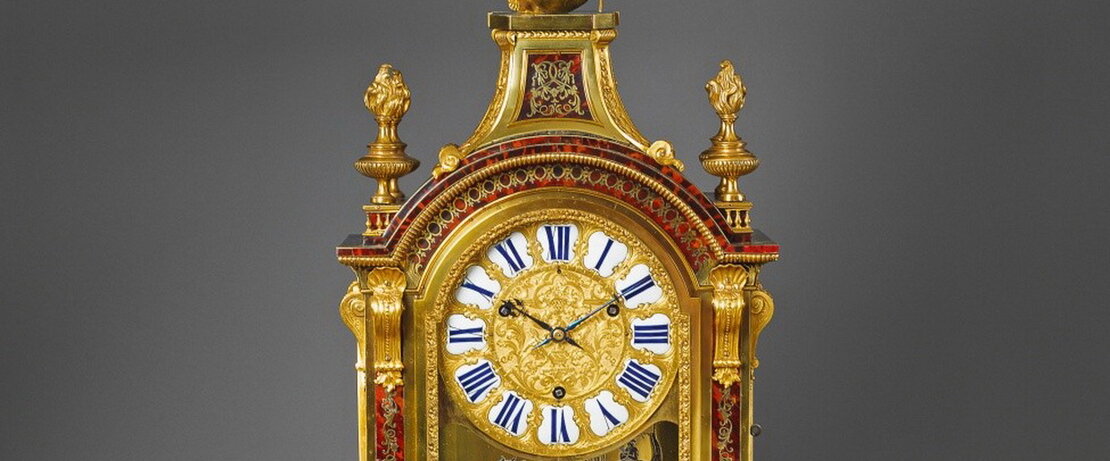Decorative Arts - exceptional furniture
The highlight of the auction is the pendule à barométre after a famous model by André Charles Boulle, once found in the collection of The Time Museum, Rockford Illinois. This important museum piece is estimated at 270/300.000 (lot 491).

Amongst the interesting furniture of the second half 19th century to be offered is a pair of highly decorative corner cabinets featuring corromandel panels from the Kangxi period (lot 524, 70/80.000). Also of interest is a complete furniture ensemble from 1830-40, partly after Danhauser designs, once found in Miramar Castle (lot 537, 100/200.000). One further piece of court furniture which must not be overlooked is a small Guéridon from Johannes Klinkerfuß made for the Württemberg court featuring a porcelain panel painted by Queen Charlotte Auguste Mathilde von Württemberg in 1813 (lot 527, 25/30.000). The Queen was a keen porcelain painter and 147 pieces are known to be by her hand.
An important large format gothic embroidery, from a central German cloister workshop after 1500, depicts the six holy saints, full length in a row. The embroidery was probably altered to be used also as an antependium (lot 461, 10/15.000). An impressive, large Stollenschrank, at one time in the collection of Emile Gavet and dated to the first half 16th century in the auction catalogue from 1897, is now catalogued as Renaissance-style. At the time one made a comparison to a similar piece formerly in the d’Yvon collection. The lot is estimated at 40/60.000 (lot 462).
The early furniture on offer also includes three cabinets from the end 16th/beginning 17th century, as well as a rare Egerer cabinet with original silver fittings (lot 490, 26/30.000). A grand baroque Italian house altar with a silver-embossed devotional picture in a pietre dure frame is valued at 40/60.000 (lot 484). A rare French Renaissance box of gold-inlaid iron with a hidden locking mechanism has an estimate of 10/15.000 (lot 463). A Renaissance travel instrument signed by Paulus Reinman comes from the Brügelmann collection, with comparable pieces only found in a few large museum collections (lot 473, 3/4.000). A Dresden game board stands out amongst the historical objects, designed after a Renaissance model, featuring the coat of arms and daguerreotypes of the owners along with inlaid porcelain panels depicting views of Saxony (lot 547, 12/14.000).
The ceramics will be offered for sale on Friday evening. The session begins with a series of important pieces of Majolica from the manufacturer Grue of Castelli d'Abruzzo, including a picture panel signed by Dr. Francesco Antonio Saverino Grue and dated 1727 (lot 575, 28/30.000). The last section is rounded off by the Strasbourg Fayence pieces from the collection of Dr. Günther Grethe. This in turn leads to the sale of porcelains featuring many exceptional pieces from a large Rhenish collection of Meissen porcelain which has been in the same family for many generations. One example is a rare cup with a portrait of a gentleman writing a letter, attributed to Johann Gregorius Hoeroldt (lot 608, 8/10.000), an impressive tankard decorated with chinoiserie and Chinese figures (lot 615, 30/40.000), a very rare cup with blue enamel chinoiserie decoration (lot 621, 15/20.000), a Meissen service with large kauffahrtei scenes in sepiacamaieu (lot 632, 15/20.000), as well as various service pieces with enchanting kakiemon decoration and engraved palace inventory numbers. A small collection of Frankenthal figures enriches the offering, with examples such as the couple Hanswurst and Columbine, Lanz figures, with lively decoration (lot 654, 10/15.000). Both comic figures, the man as well as the woman, have beards. Also of particular interest is a Meissen billy goat, the Kaendler model featuring later decoration (lot 642, 35/40.000). The wide offering of silver stretches from the Renaissance into the 20th century, including numerous Rhenish pieces from Cologne and Düsseldorf, but also Kempen, Neersen or Xanten, and from Hamburg a rare, small aquilegia goblet from the Master Heinrich Ohmßen (lot 69, 15/18.000). Further interesting pieces include a museum-quality lidded tankard from the Nurenburg Master Johann Jacob Wolrab from around 1690 (lot 112, 24/26.000), twelve engraved travel pharmaceutical boxes of the Swedish King Fredrik I (lot 138, 20/24.000), or a rare trophy cup of a Jewish brotherhood, probably Weißenfels, from around 1830 (lot 66, 32/35.000). The modern silver on offer includes 20 works from the estate of the Cologne gold and silversmith Wilhelm Nagel who designed and created the DFB trophy in the 1960s (lots 205-224, Euro 500-16.000). An English collection of unusual intaglios and cameos shine out in the jewellery section, a collection based on important stone cutters of the classical glyptic arts. One oval cornelian with a Ceres head is signed Pichler (lot 293, 5.5/6.000), whilst a further cornelian is from the Tiffany workshop around 1860 (lot 294, 4/4.5000). A classical intaglio set in a modern necklace once belonged to Prince Stanislow Poniatowski (lot 296, 5.5/6.000). Roman intaglios however are also in the collection such as an Imperial era example which was once owned by the Duke of Wellington (lot 283, 6.5/7.500). Amongst the historical jewellery can be found a rare orient pearl sautoir, owned in the first half of the 20th century by Margaret v. Campe, née v. Guilleaume (lot 343, 12/15.000).
